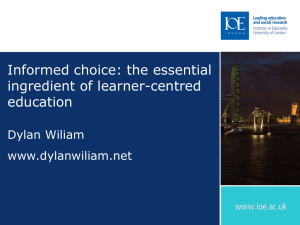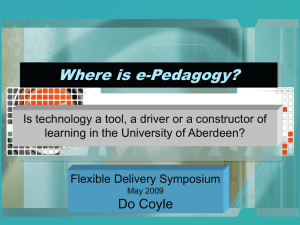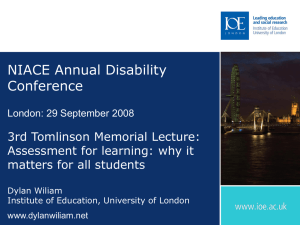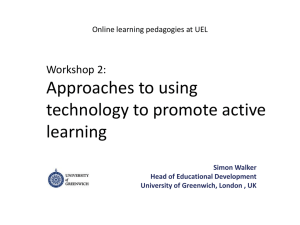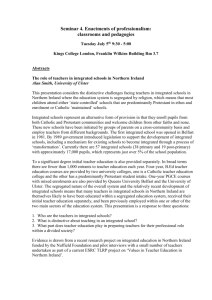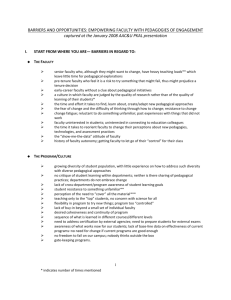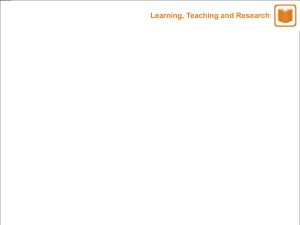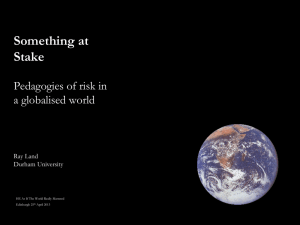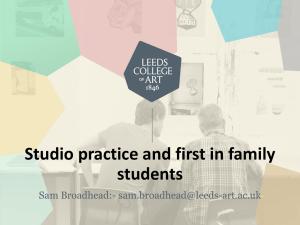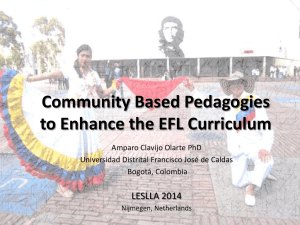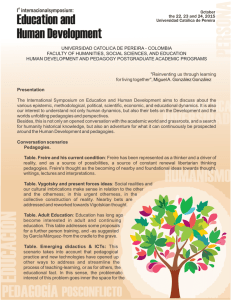The importance of teaching
advertisement
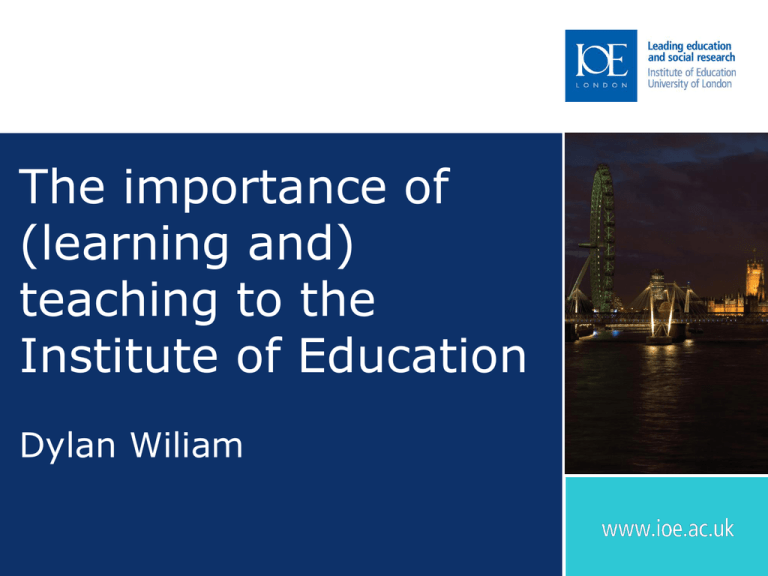
The importance of (learning and) teaching to the Institute of Education Dylan Wiliam A brief history of HE funding… Integration of funding pre-1992 and post-1992 universities Research Quality based mechanism (RAE) QR supports a maximum of 50% of academic staff salary Teaching Quality-independent mechanism (tolerance bands) Fee caps too low for discrimination between providers Commodification of teaching Future developments Quality-related student contributions to tuition costs Need to achieve, and demonstrate, increased quality The ‘death of distance’ for distance learning students but also for students attending full-time To secure its future, the Institute needs to become as demonstrably excellent for its teaching as it is for its research Enrolment on modules in 2008 Policy minimum: 23 students per module 50 40 30 20 2006 2008 Mean: 15 18 Median 12 16 Mode 11 15 10 0 25 50 Number of students 75 Teaching: a scarily complex activity (Denvir & Brown, 1986) …and we are largely on our own… Two extremes Teachers doing the learning for the learners Teachers “facilitating learning” Key concept Teachers do not create learning Learners create learning But all teachers can do is teach (learning vs. teaching) Teaching is the engineering of effective learning environments Psychology underdetermines pedagogy Teaching is fundamentally a creative activity Creativity is very widely distributed, but often suppressed Principles of curriculum design Curriculum: a selection from culture Balanced Rigorous Vertically integrated Focused The test of successful education is not the amount of knowledge that a pupil takes away from school, but his appetite to know and his capacity to learn. If the school sends out children with the desire for knowledge and some idea how to acquire it, it will have done its work. Too many leave school with the appetite killed and the mind loaded with undigested lumps of information. The good schoolmaster is known by the number of valuable subjects which he declines to teach. (Sir Richard Livingstone, President of Corpus Christi College, Oxford, 1941) Signature pedagogies In Law In Medicine Effective learning environments Create student engagement pedagogies of engagement Well-regulated pedagogies of contingency Develop habits of mind pedagogies of formation Pedagogies of engagement Intelligence is partly inherited So what? Intelligence is partly environmental Environment creates intelligence Intelligence creates environment Dual-pathway theory (Boekaerts) Well-being Growth Learning environments Inclusive Varied Efficient Active learning roles? The TIMSS video studies of middle-school mathematics classrooms looked at the proportion of teacher words to student words in randomly selected examples of classroom practice USA 8 Japan 13 Hong Kong 16 Hinge-point question On average, across all the award-bearing teaching at the Institute,how many teacher words are there per student word? A. More student words than teacher words B. About equal numbers of teacher words and student words C. Three times as many teacher words as student words D. Five times as many teacher words as student words E. More than five times as many teacher words as student words Motivation: cause or effect? high arousal Flow anxiety challenge control worry relaxation apathy boredom low low competence high (Csikszentmihalyi, 1990) Pedagogies of contingency Learning is unpredictable Learners do not learn what we teach It is only through assessment that we can connect what we do as teachers to its outcomes (“like so many bottles thrown out into the sea”; Perrenoud 1998) Assessment is therefore the bridge between teaching and learning, and thus the central process of teaching (as opposed to lecturing) A large, and growing literature providing evidence of the beneficial effects of formative assessment Formative assessment An assessment functions formatively when evidence about student achievement elicited by the assessment is interpreted and used to make decisions about the next steps in instruction that are likely to be better, or better founded, than the decisions that would have been made in the absence of that evidence. Formative assessment therefore involves the creation of, and capitalization upon, moments of contingency (short, medium and long cycle) in instruction with a view to regulating learning (proactive, interactive, and retroactive). Dealing with diversity Ignore it (“one-size-fits-all”) Individualize instruction (“made-to-measure”) Personalization Mass customization (rather than mass production or individualization) Diversity becomes a valuable instructional resource Hinge-point question An experimental study of a new method of teaching reading reports that a result was significant (p<0.05). This means that: A. The experimental group out-performed the control group by 5% B. There is a 5% chance that the experimental group did not out-perform the control group C. There is a 5% chance that there is no difference between the experimental group and the treatment group D. There is only a 5% chance that the observed result would have happened if the experimental and control groups had the same achievement Hinge-point question Which of the following is the most important difference between the theories of Piaget and Vygotsky? A. Piaget places greater importance on the role of conservation in cognitive development. B. Vygotsky places greater importance on the role of cultural artifacts in cognitive development. C. Vygotsky did not believe in distinct stages of cognitive development. D. Piaget was a social constructivist while Vygotsky placed greater emphasis on cultural-historical activity theory Other supports for contingency All-student response systems ABCD cards “Exit-pass” questions Hinge-point question Summarize the key principles of the following schools of psychology on the appropriate coloured card Associationism (blue) Information processing (orange) Constructivism (red) Situated approaches (green) Pedagogies of formation Instilling disciplinary habits of mind History Philosophy Statistics Instilling critical perspectives Values Improving our practice The limitations of consciousness Sensory system Eyes Ears Skin Taste Smell Total bandwidth (in bits/second) 10,000,000 100,000 1,000,000 1,000 100,000 Conscious bandwidth (in bits/second) 40 30 5 1 1 (Nørretranders, 1998) Knowledge ‘transfer’ and creation to Tacit knowledge Explicit knowledge Dialogue Tacit knowledge from Explicit knowledge Socialization Externalization sympathised knowledge conceptual knowledge Networking Sharing experience Internalization Combination operational knowledge systemic knowledge Learning by doing After Nonaka & Tageuchi, 1995 Improvements in pediatric cardiac surgery Senning Early death rate Senning 12% Transitional 25% Transitional Switch Bull, et al (2000). BMJ, 320, 1168-1173. Impact on life expectancy Life expectancy: Senning: 46.6 years Switch: 62.6 years No excuse for making the same mistakes over and over again But no excuse for not making mistakes “Make new mistakes” (Esther Dyson) Summary Excellence in teaching is vital to the future success of the Institute Every single one of us needs to improve as a teacher Not because we are not good enough But because we can be better The Institute needs to play a leading role in developing signature pedagogies for Education and related Social Science Closing thoughts “In a completely rational society, the best of us would aspire to be teachers and the rest of us would have to settle for less, because passing civilization along from one generation to the next ought to be the highest honor and highest responsibility anyone could have.” Lee Iacocca “Our deepest fear is not that we are inadequate. Our deepest fear is that we are powerful beyond measure. It is our light, not our darkness, that most frightens us.” Marianne Williamson, A return to love
